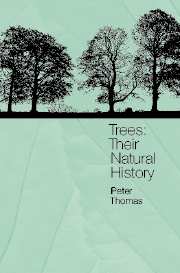Book contents
- Frontmatter
- Contents
- Preface
- 1 An overview
- 2 Leaves: the food producers
- 3 Trunk and branches: more than a connecting drainpipe
- 4 Roots: the hidden tree
- 5 Towards the next generation: flowers, fruits and seeds
- 6 The growing tree
- 7 The shape of trees
- 8 The next generation: new trees from old
- 9 Health, damage and death: living in a hostile world
- Further reading
- Index
9 - Health, damage and death: living in a hostile world
Published online by Cambridge University Press: 05 September 2012
- Frontmatter
- Contents
- Preface
- 1 An overview
- 2 Leaves: the food producers
- 3 Trunk and branches: more than a connecting drainpipe
- 4 Roots: the hidden tree
- 5 Towards the next generation: flowers, fruits and seeds
- 6 The growing tree
- 7 The shape of trees
- 8 The next generation: new trees from old
- 9 Health, damage and death: living in a hostile world
- Further reading
- Index
Summary
It's a tough world. Trees face a constant battle in competing for light, water and minerals with surrounding plants. As if that were not enough, they also have to fend off the attention of living things, which view trees as good to eat and places to live. Insects chew away on all parts of a tree and are quite capable of completely defoliating it. Larger leaf-eating animals (which are usually on the ground since a belly full of compost heap is a heavy thing to carry around; leaf eating monkeys are an exception) chew away at the lower parts of the tree, although giraffes can reach up around 5.5 m. Whole armies of animals that can climb and fly will feed on the more nutritious flowers, fruits and the sugar-filled inner bark (see Chapter 3). The grey squirrel, introduced to Britain from N America in the 1880s, is a prime example. This rodent does extensive damage to hardwoods by stripping bark in spring to get at the sweet sap. It seems that dense stands of selfsown hardwoods have little sap and are largely immune (which may be why it does not cause problems in its native home) but well-tended planted trees have thin bark and a high sap content and are mercilessly attacked. So big is the problem that ash, lime and wild cherry may become more common in Britain because of their relatively low palatability to squirrels at the expense of palatable beech and sycamore.
- Type
- Chapter
- Information
- TreesTheir Natural History, pp. 231 - 268Publisher: Cambridge University PressPrint publication year: 2000



